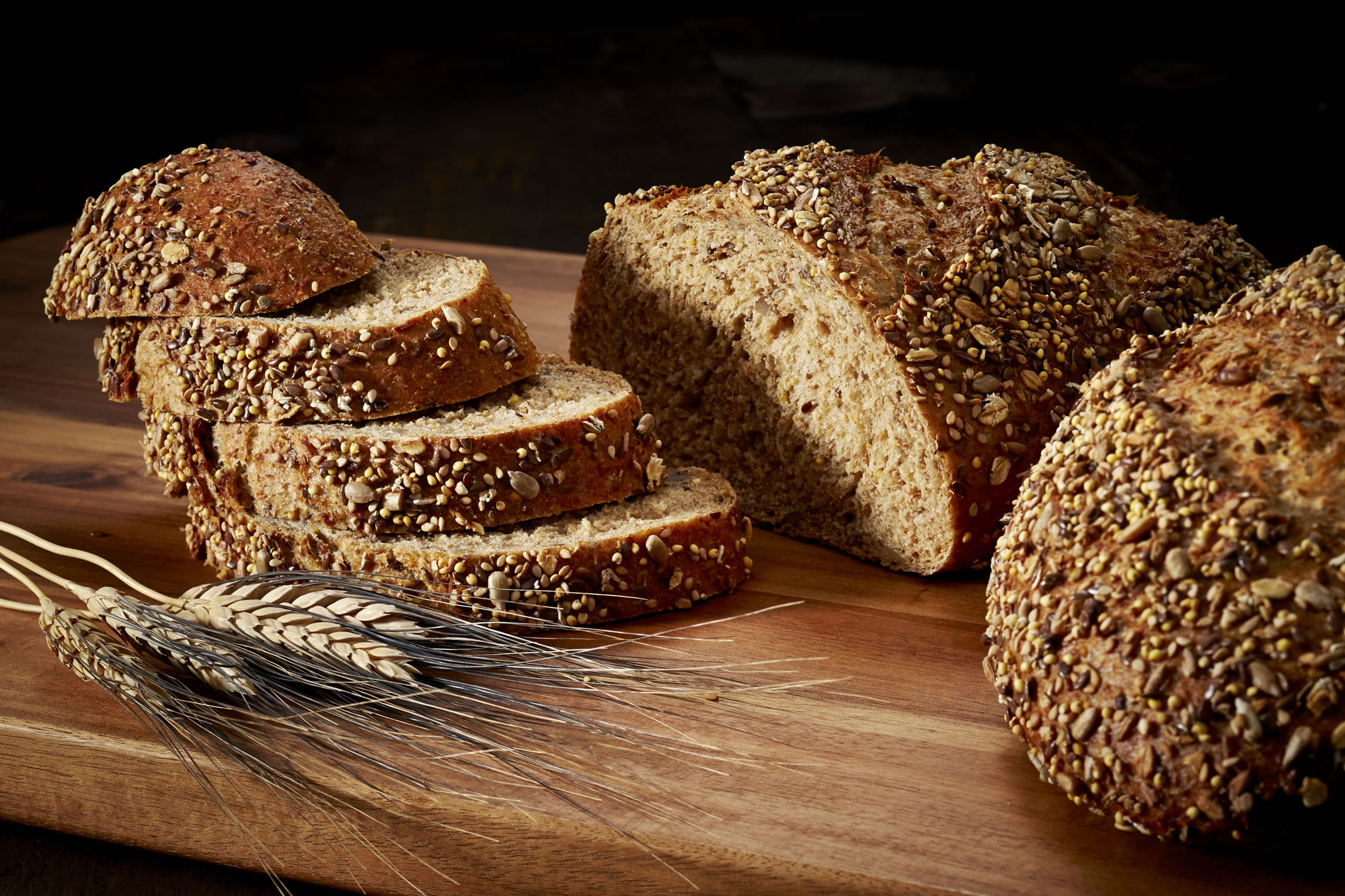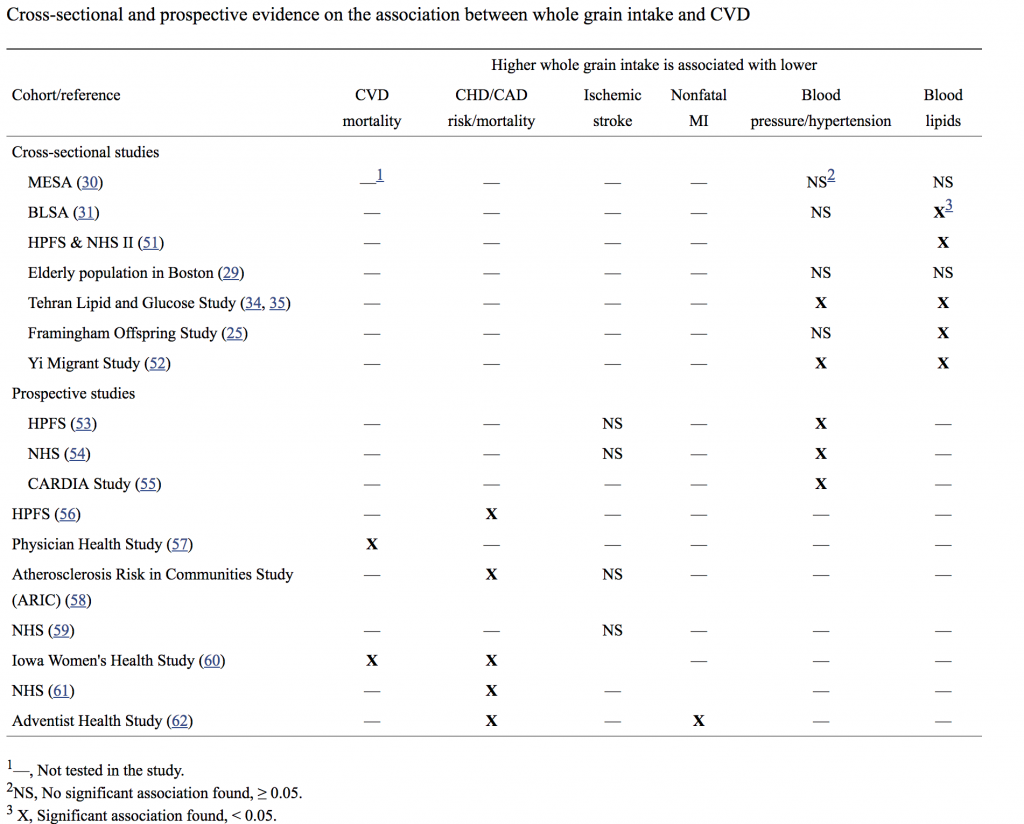Whole Grain, Stone Ground, Organic Bread: It’s Good For You!
If you’ve been reading my blog, you already know that I’m a big proponent of including grains in our daily diet. Not just any grains, though. Grains that are healthful for us are organic, whole grains, enjoyed either in their whole form or as freshly milled flour.
Despite the current dietary fad of shunning all grains, a growing body of evidence shows that increased intake of less-refined, whole-grain foods has numerous positive health benefits. People who consume greater amounts of whole grains are consistently shown to have a lower risk of developing cardiovascular disease, type 2-diabetes, and many cancers. People who eat whole grains also appear to have better digestive health and are likely to have a lower BMI and gain less weight over time. The bulk of the evidence for the advantages of whole-grains comes from observational studies, but researchers are discovering the same benefits in intervention studies, and are identifying the mechanisms behind the protective properties of whole grains.1
Whole Grains Protect Against Cardiovascular Disease
Here’s an example of the health protective benefits of whole grains: A meta-analysis of seven major studies showed that cardiovascular disease (heart attack, stroke, or the need for a procedure to bypass or open a clogged artery) was 21% less likely in people who ate 2.5 or more servings of whole-grain foods per day compared with those who ate less than 2 servings per week.2
In a study on the association between a high-quality carbohydrate index (CQI) and cardiovascular health, researchers found that a better quality of dietary carbohydrates (measured by the CQI) showed a significant inverse association with the incidence of CVD. Specially, a higher proportion of carbohydrates from whole grains was strongly inversely associated with CVD.
These findings make it clear that “heart-healthy” diets should be focused not only on carbohydrate quantity but also on an assessment of the type and quality of carbohydrates. This means focusing on organic whole grains while avoiding processed, refined grains and flours.3
Putting the Whole Grain Puzzle Together: Health Benefits Associated with Whole Grains4
A 2016 meta-analysis of thirteen studies on total mortality (104,061 deaths), 12 on CVD mortality (26,352 deaths), and 8 on cancer mortality (34,797 deaths) found that there was a significant inverse relationship between whole-grain intake and mortality due to any cause, CVD, or cancer.5
In addition, a 2017 meta-analysis of over 1 million participants found that each 28 g/d intake of whole grains was associated with a 9% lower risk for total mortality, 14% lower risk for CVD mortality and 3% lower risk for cancer mortality.6
Whole Grains: The Best Food for Gut Microbial and Immune Health
Two clinical trials from Tufts University, published recently in the American Journal of Clinical Nutrition, show that that substituting whole grains for refined grains, even for a short period, improves the balance of intestinal microbes and enhances immune response and energy metabolism.
Both studies involved healthy adults (ages 40 to 65), half of whom consumed a diet rich in whole grains (whole wheat, oats, and brown rice) for six weeks, while the rest ate refined grains. Other than the different grains, the diets were virtually the same. The whole grains provided about twice as much fiber (mostly insoluble fiber) as well as some extra nutrients and other potentially beneficial compounds.
The results of the studies revealed two noteworthy findings:
- Whole grains create a happier microbiome. To determine the effect of whole grains on the microbiome, researchers analyzed the participants’ stool for bacterial content and concentration of fats. Previous research has shown that whole grains increase microbiome diversity and boost production of short-chain fatty acids, both of which are linked to improved immune function and digestive health. Along these lines, the whole-grain group showed an increase in bacteria that produce short-chain fatty acids and a decrease in pro-inflammatory bacteria, among other positive changes, compared to those eating refined grains. Blood samples from the whole-grain group also showed improvements in several markers of immune response.7
- Whole grains negate calories. This fascinating finding indicates that consuming whole grains can promote weight loss. The researchers discovered that whole grain consumption led to decreased calorie retention during digestion (as measured by calories in stool) and a slightly higher resting metabolic rate—resulting in a net daily energy loss of 92 calories per day, on average, compared to those participants consuming a refined-grain diet. Self-reported hunger and fullness were not statistically different between the two groups. The additional fecal energy losses appear to be the result of the extra fiber on the digestion of other food calories.8
How Wholegrain Wheat Differs from Refined Wheat
https://www.hsph.harvard.edu/nutritionsource/whole-grains/
Whole grain foods that undergo processing and reconstitution must deliver the same proportion of bran, germ, and endosperm as that of the original grain to be considered whole grains. The outer bran layer is composed of non-digestible, mainly insoluble, poorly fermentable carbohydrates (such as cellulose, hemicelluloses, arabinoxylan), and the inner germ and starchy endosperm contain viscous soluble fibers, fermentable oligosaccharides, resistant starch (RS), lignans, vitamins, minerals, polyphenols, oils, and other phytonutrients.
During the refining of whole grains into white flour, the outer bran and inner germ layers are removed and the remaining endosperm is processed into flour. Thus, compared with refined grains, whole grains are inherently richer in dietary fiber, containing 80% more dietary fiber than refined grains. Furthermore, as a consequence of the refining process, there are substantial losses in essential minerals, vitamins, and phytonutrients.9.10
The Remarkable Antioxidant Properties of Whole Grains
Whole grains are rich sources of vitamins, minerals, dietary fiber, lignans, β-glucan, inulin, numerous phytochemicals, phytosterols, phytin, and sphingolipids. In wheat kernels, ferulic acid and other phenolic acids provide protection by generating physical and chemical barriers through cross-linking with carbohydrates; these antioxidant activities combat destructive radicals.11
The phenolic acid concentration of whole grains corresponds to their total antioxidant capacities. Corn has the highest phenolic acid content, followed by wheat, oats, and rice, with 265, 136, 111, and 95 mg gallic acid equivalents/100 g, respectively.12
Although fruits and vegetables are widely recognized for their antioxidant benefits, whole grains offer equal and even greater antioxidant protection. For example, the antioxidant capacity of whole grain breakfast cereals ranges from 2200 to 3500 Trolox equivalents (TE). (Trolox is a water-soluble analog of vitamin E.) In comparison, the antioxidant capacity of fruits generally ranges from 600 to 1700 TE, with a high of 2200 TE for red plums and 3600 TE for berries. Vegetables average 450 TE, with a high of 1400 TE for red cabbage.13,14
Carotenoids are another group of compounds found in whole grains. Lutein, zeaxanthin, β-cryptoxanthin, β-carotene, and α-carotene are the most common carotenoids and are commonly concentrated in the bran or germ portion of whole grains.15
Micronutrients such as folate and vitamin B-6, polyphenols, and antioxidant compounds, along with prebiotics such as inulin, oligosaccharides and immune modulators such as β-glucan found in whole grains work synergistically to lower oxidative stress, inflammation, and pathogen load.16
It’s obvious that including whole grains in our daily diet offers many more benefits than just extra roughage. Researchers are just beginning to recognize the many ways that whole grains improve our health, from nourishing the gut biome and improving metabolism to providing powerful antioxidants that help prevent cancer and cardiovascular disease. Stay tuned for more on this topic—I’ll be sharing some of the ways that bread, made from fresh, organic stone ground whole grains, provides us with a unique source of emotional and spiritual sustenance.
Research
- Seal CJ, Brownlee IA. Whole-grain foods and chronic disease: evidence from epidemiological and intervention studies, Proc Nutr Soc. 2015 Aug;74(3):313-9. doi: 10.1017/S0029665115002104.
- Mellen PB, Walsh TF, Herrington DM. Whole grain intake and cardiovascular disease: a meta-analysis. Nutr Metab Cardiovasc Dis. 2008;18:283-90.
- Segui-Gomez, M. Nutr Metab Cardiovasc Dis. 2016 Jul 12. pii: S0939-4753(16)30109-0. doi: 10.1016/j.numecd.2016.07.002.
- Jonnalagadda S, Harnack L, Liu R, et al. Putting the Whole Grain Puzzle Together: Health Benefits Associated with Whole Grains—Summary of American Society for Nutrition 2010 Satellite Symposium, J. Nutr. 141: 1011S–1022S, 2011.
- Chen G, Tong X, Xu J, et al. Whole-grain intake and total, cardiovascular, and cancer mortality: a systematic review and meta-analysis of prospective studies; American Journal of Clinical Nutrition (May 2016)
- Zhang B1, Zhao Q2, Guo W1, et al. Eur J Clin Nutr. 2017 Nov 1. doi: 10.1038/ejcn.2017.149.
- Vanegas, S.M., et. al., Substituting whole grains for refined grains in a 6-wk randomized trial has a modest effect on gut microbiota and immune and inflammatory markers of healthy adults, Am J Clin Nutr October 2017 106: 1052-1061; First published online August 16, 2017. doi:10.3945/ajcn.117.155424.
- Karl, J.P. et. al., Substituting whole grains for refined grains in a 6-wk randomized trial favorably affects energy-balance metrics in healthy men and postmenopausal womenAm J Clin Nutr ajcn139683; First published online February 8, 2017.
- Okarter N, Liu RH. Health benefits of whole grain phytochemicals. Crit Rev Food Sci Nutr 2010;50:193–208
- USDA, Agricultural Research Service. USDA National Nutrient Database for Standard Reference, Release 22. Nutrient Data Laboratory Home Page; 2009. [cited 2010 Jun 1]. Available from: http://www.ars.usda.gov/ba/bhnrc/ndl
- Adom KK, Sorrells ME, Liu RH. Phytochemicals and antioxidant activity of milled fractions of different wheat varieties. J Agric Food Chem. 2005 Mar 23; 53(6):2297-306.
- Adom KK, Liu RH. Antioxidant activity of grains. J Agric Food Chem. 2002 Oct 9; 50(21):6182-7.
- Miller HE, Rigelhof F, Marquart L, et al. Antioxidant content of whole grain breakfast cereals, fruits and vegetables. J Am Coll Nutr. 2000 Jun; 19(3 Suppl):312S-319S.
- Okarter N, Liu RH., Health benefits of whole grain phytochemicals. Crit Rev Food Sci Nutr. 2010 Mar; 50(3):193-208.
- Adom KK, Sorrells ME, Liu RH. Phytochemicals and antioxidant activity of milled fractions of different wheat varieties. J Agric Food Chem 2005;53:2297–306.
- Jonnalagadda S, Harnack L, Liu R, et al. Putting the Whole Grain Puzzle Together: Health Benefits Associated with Whole Grains—Summary of American Society for Nutrition 2010 Satellite Symposium, J. Nutr. 141: 1011S–1022S, 2011.




I like how the article explains that eating whole grain bread can help to reduce the likeliness of getting a cardiovascular disease. Cardiovascular diseases run in my family and I don’t want to get a cardiovascular disease so I look for ways to help prevent myself from getting it. Maybe eating whole grain bread can help me to reduce the chance of getting a cardiovascular disease.